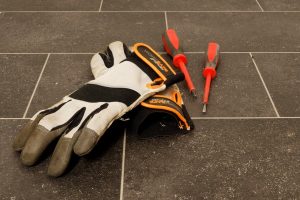Like in any other trade, workers in the electrical industry face hazards on the job.
That’s why they have to wear personal protective equipment (PPE) to reduce the risk they face.
The PPE would ensure that the hazard is minimal while allowing them to do their job efficiently.
Below, you’ll learn the essential PPE items that electricians use to reduce the risk of workplace injury.
Important PPE Items of an Electrician
In this industry, PPE is equivalent to saying, “better safe than sorry.”
While working with electricity, electricians are exposed to multiple hazards that can seriously impact their lives.
And so, employers ensure that their workers are provided with PPE and follow the safety guidelines.
Electricians will wear the following important safety items:
Insulating Gloves
These are rubber gloves of two types: Type 1 and Type 2.
With Type 1, an electrician can have more flexibility but aren’t ozone resistant.
So, with exposure to UV rays, they start cracking.
Meanwhile, Type 2 gloves are ozone resistant but don’t have that much flexibility.
Protector Gloves
Even though the rubber doesn’t conduct electricity, protector gloves should go over the insulating gloves.
It reduces the risk of burns and exposure to electrical shock.
Eye Protection
In any live electrical environment, workers can be exposed to electric arc flashes.
Eye protection is essential to protect their eyes from anything that can get into them and impair their vision.
Head Protection
Electricians often work on construction sites, so there is a risk of objects falling.
There is also electricity-related risk while they are working.
Helmets come in three categories: Class A, Class B, and Class C.
Class A reduces the impact of falling objects and the danger that comes from contact with low-voltage electricity.
These helmets are tested at 2,200 volts.
Class B also reduces the impact of falling objects and the danger from contact with high-voltage electricity.
They are tested at 20,000 volts.
Class C reduces the impact of falling objects but does not protect against electricity.
They don’t really have any use for electricians contacting live electricity.
Protective Footwear
Protective footwear should be worn when a worker is exposed to…
- Rolling or falling objects
- Objects piercing the sole
- Electrical hazard
Electrical shock-resistant (EH) footwear is made with heels and soles that don’t conduct electricity.
This type of footwear should be able to withstand 14,000 volts at 60 hertz per minute to ensure the highest level of protection.
This page is also available in Spanish.










